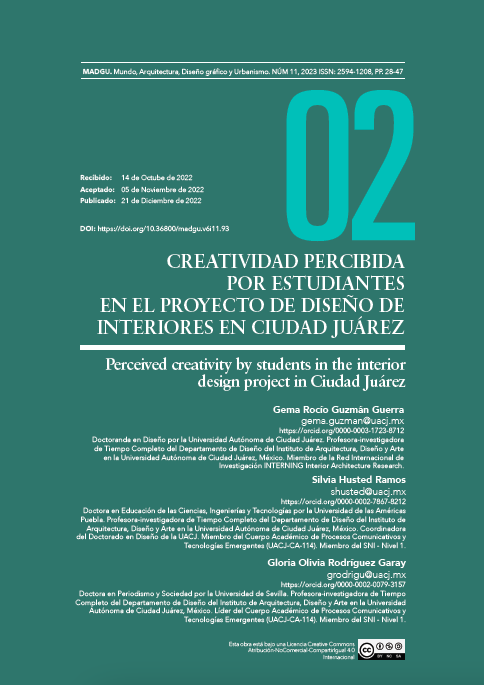Creatividad percibida por estudiantes en el proyecto de diseño de interiores
Keywords:
creativity, indicators, design studio, project, interior designAbstract
In the interior design studio, creativity is an essential component, since it is where the student explores diverse skills according to professional practice, aimed at providing solutions to interior spaces in an attractive and efficient way. The research objective is to identify notions about the creativity concept among students, as well as characteristics associated with interior design projects that are considered outstanding in the academic context. Work was done with a non-probabilistic sample chosen at convenience according to the specific UACJ students’ profile in a current design studio subject; the approach was carried out through the application of a survey, elaborated based on topics identified by experts in the development of interior design projects. From the results’ statical analysis adjectives associated with creativity were identified, highlighting imaginative, ingenious, and novel, as well as the main correlations between the variables in question. Three important components associated to creativity also stood out: relevance, innovation, and authenticity. It is essential to identify the perception of creativity from the university context, to establish a definition that integrates the indicators associated with it in the interior design projects and to verify the expected results of the design proposals.
Downloads
References
Amabile, T. M. (1983). The Social Psychology of Creativity: A Componential Conceptualization. Journal of Personality and Social Psychology, 45(2), 357-376.
Chacón, Y. (2005). Una revisión crítica del concepto de creatividad. Revista Electrónica “Actualidades Investigativas en Educación”, 5(1). [Fecha de consulta 16 de noviembre de 2021]. Disponible en: https://www.redalyc.org/articulo.oa?id=44750106
Csikszentmihályi, M. (1998). Creatividad. El fluir y la psicología del descubrimiento y la invención. Barcelona: Paidós.
Doheim, R. y Yusof, N. (2020). Creativity in Architecture Design Studio. Assessing Students’ and instructors’ perception. Journal of Cleaner Production, 249. Disponible en: https://www.sciencedirect.com/science/article/pii/S095965261934288X
Dreifuss, C. (2015). Enseñanza-aprendizaje en el taller de diseño. Limaq: Revista de Arquitectura de la Universidad de Lima, (1), 67-92.
Drevdahl, J. E. (1956). Factors of importance for creativity. Journal of Clinical Psychology, 12, 21-26.
Guilford, J.P. (1950). Creativity. The American Psychologist, 5(9), 444-454.
Kaufman, J. (2016). Creativity 101. Nueva York: Springer Publishing Company.
Muratovski, G. (2016). Research for designers. A guide to methods and practice. Londres: SAGE Publications.
Pedersen, E. y Burton, K. (2009). A Concept Analysis of Creativity: Uses of Creativity in Selected Design Journals. Journal of Interior Design, 35(1), 15-32.
Rodríguez, E. (2005). Metodología de la investigación. Villahermosa: Universidad Juárez Autónoma de Tabasco.
Salama, A. M. y Wilkinson, N. (2007). Design Studio Pedagogy: Horizons for the Future. Gateshead. Londres: The Urban International Press.
Simonton, D. (2012). Taking the U.S. Patent Office Criteria Seriously: A Quantitative Three Criterion Creativity Definition and Its Implications. Creativity Research Journal, 24 (2-3), 97-106.
Sternberg, R. J. y Lubart, T. I. (1991). An Investment Theory of Creativity and Its Development. Human Development, 34, 1-31.
Torrance, E. P. (1977). Creativity in classroom: what research says to the teacher. Washington: National Education Association.

Downloads
Published
How to Cite
Issue
Section
License
Copyright (c) 2022 Gema Rocío Guzmán Guerra

This work is licensed under a Creative Commons Attribution-NonCommercial-ShareAlike 4.0 International License.
Las opiniones expresadas por los autores no necesariamente reflejan la postura del editor de la publicación. Esta obra está bajo una Licencia Creative Commons Atribución-NoComercial-CompartirIgual 4.0 Internacional.








